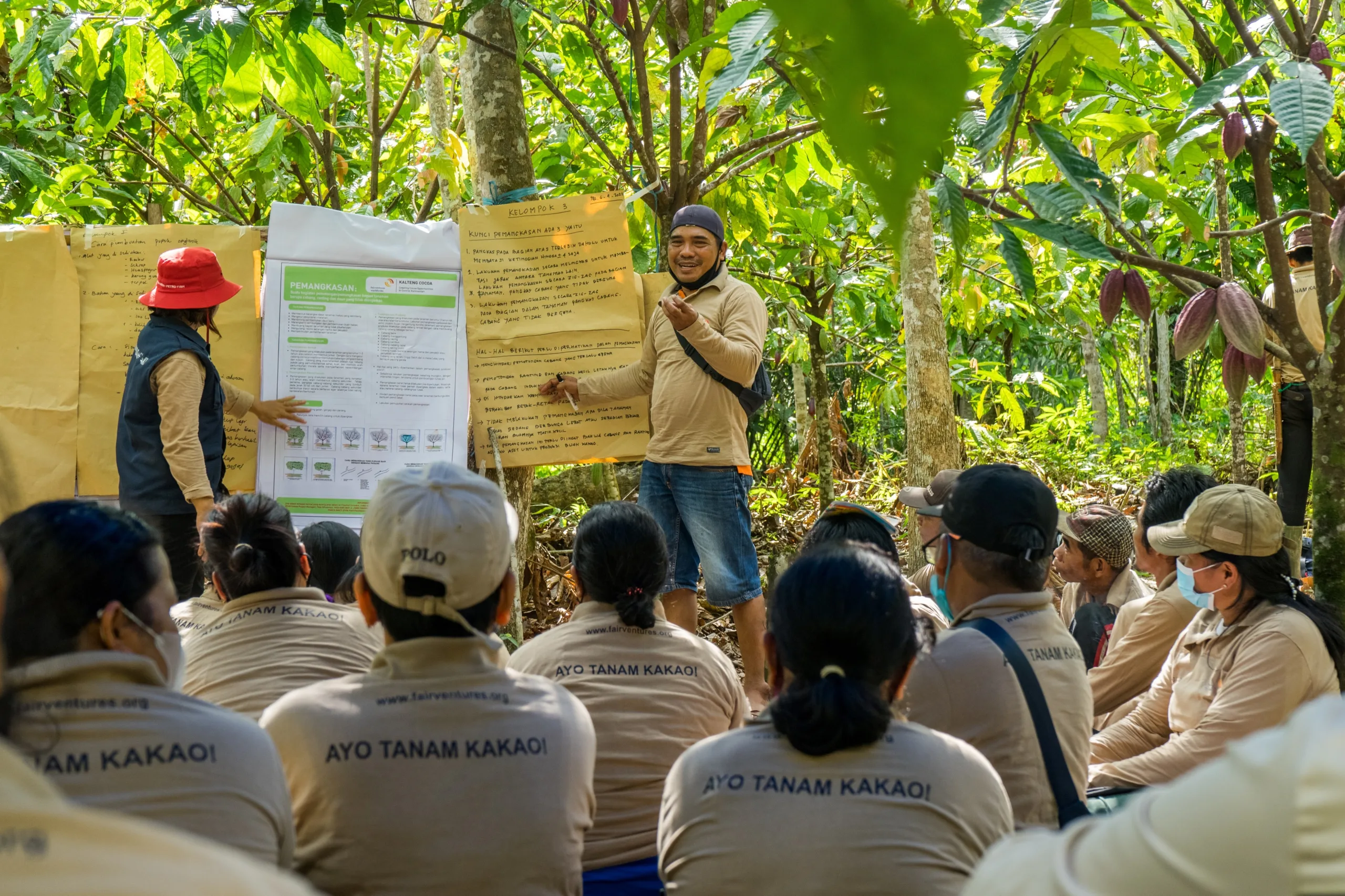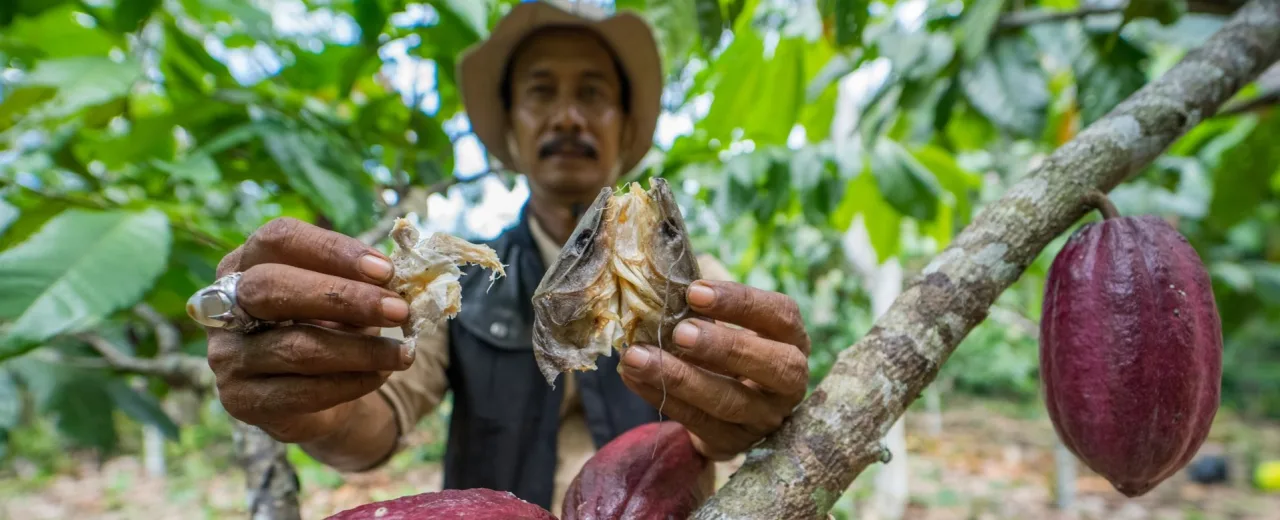 More income through training
More income through training
Properly plant and care for cocoa trees and harvest high-quality cocoa beans
Do you already have a chocolate Santa at home? Last Christmas season, around 169 million of them were produced in Germany alone (EHI Retail Institute GmbH, 2023). In total, almost 13 kg of chocolate are produced per capita in Germany every year (Federal Statistical Office, 2022). That would be roughly the amount of two and a half chocolate bars per person per week. In order to be able to produce chocolate at all, cocoa beans are needed. The cocoa beans for production have to be imported from other countries. Some of these cocoa beans come from Indonesia. Although the Ivory Coast and Ghana are by far the largest producers, cocoa cultivation in Indonesia is particularly promising (Fountain, A.C. & Hütz-Adams, F., 2022). By growing cocoa trees in the shade of indigenous, fast-growing light wood species, in the so-called agroforestry system, smallholder farmers can increase income for themselves and their families and at the same time make a contribution to the climate.
Necessity
Further education for cocoa farmers in Borneo
Activity
Local trainers teach cocoa farmers how to grow cocoa in the agroforestry system
Countable effort
Number of trained smallholder farmers
Result
50 cocoa farmers were trained to grow cocoa in the agroforestry system
Systemic effect
Improved income for cocoa farmers and their families as well as protection and enhancement of the land used through agroforestry practice
Background
Cocoa is almost exclusively produced by smallholder farmers (Bermudez et.al., 2022). The main cultivation area in Indonesia is currently Sulawesi. Cocoa cultivation in Kalimantan on the island of Borneo is not yet very widespread, although the good taste and high quality of the cocoa from this region has already convinced some chocolate manufacturers. Due to a lack of structures, farmers in the rural regions of Borneo are not always able to finance the livelihood of themselves and their families with the sale of cocoa beans. The majority of the cocoa value chain is managed by a few large cocoa traders and processors (Gayi, S. K. & Tsowou, K., 2017). Among other things, such “chocolate giants” create price pressure on smallholder farmers, which they cannot keep up with. Overall, this leads to poor working conditions in the cocoa sector and to further deforestation in order to obtain more income from more land for cocoa (BMZ 2019). German chocolate consumption is not unconnected to this (GIZ 2023), e.g. almost 10 kg per capita were consumed in 2022 (Tagesspiegel 2023). Strengthening individual cocoa farmers can lead to a better position on the market and thus to more income. The first step is to train the smallholder farmers. The more knowledge they have about the cultivation and care of the cocoa trees as well as the harvesting and processing of the cocoa fruit, the higher the quality of the cocoa beans. With high quality cocoa beans, a better income can also be achieved.
The good deed
With this good deed, you enable cocoa farmers in Borneo to participate in so-called Farmer Field Schools. The training imparts knowledge and technical skills to increase cocoa production and quality. Environmental problems are also addressed in the training courses and the cocoa farmers are encouraged to cultivate cocoa in an environmentally friendly way. Other topics include cocoa harvesting and processing, market demand and quality assurance methods. Practical exercises such as planting seedlings, tree care and ecological pest control are also part of the training. Participants also receive a manual on agroforestry (a combination of forestry and agriculture) that summarises all the information. By implementing what they have learned, the cocoa farmers in rural regions of Borneo should be able to benefit from the high demand for cocoa, especially from Europe, and improve their quality of life - without destroying the environment in the process.

About Indonesia
Jakarta
Capital
275,501,339
Number of inhabitants
4,788.0
Gross domestic product per capita per year
0,705
Human Development Index
Cocoa ceremonies on the island of Bali are very popular, especially with tourists. In spiritual events, hot raw cocoa is drunk, accompanied by ritual dances, prayers and singing.
About the organization and further information
Association
Fairventures Worldwide FVW gGmbH
Website
Further information and source
- Fountain, A. C., Hütz-Adams, F. (2022). 2022 Cocoa Barometer. Cocoa Barometer Consortium, administered by the VoIce Network.
- Bermudez, S., Voora, V., Larrea, Cr., Luna, E. (2022). Global Market Report. Cocoa prices and sustainability. International Institute for Sustainable Development.
- Gayi, S. K., & Tsowou, K. (2017). Cocoa industry: Integrating small farmers into the global value chain. United Nations.
- Statistisches Bundesamt (2022). Zahl der Woche. Fast 13 Kilo Schokolade pro Kopf wurden 2021 produziert.
- GIZ (2023). Schokolade genießen, Wälder erhalten.




